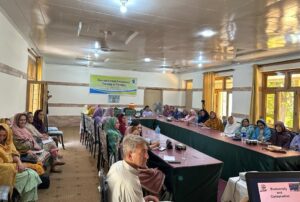Mountain Fruits Private Limited, in collaboration with Fairtrade NAPP, has helped the farmers of Damas, Ghizer in various ways such as arranging sessions on climate change adaptation, jam processing, and other skill building topics. Farmers in Damas, District Ghizer, are embracing new knowledge and practices to safeguard their livelihoods and ensure food security for their communities. This past year, Mountain Fruits Private Limited, in collaboration with Fairtrade (an organization dedicated to fairer trading conditions), facilitated an impactful two-day training session for 60 registered farmers. The sessions, a key part of Mountain Fruits annual Fairtrade activities, were expertly delivered by distinguished experts from Karakoram International University (KIU), Gilgit. The training reached into critical areas: Climate Resilient Agriculture to Ensure Food Security, Biodiversity and Conservation, Processing of Fruits, and Climate Change, Seed Germination, and Combating Strategies. This holistic approach is equipping farmers with the skills and knowledge, to understand and navigate the complexities of a changing climate and build a more sustainable agricultural future.
Climate Resilient Agriculture: A Path to Food Security.
Dr. Azhar Hussain from the Department of Agriculture & Food Technology at Karakoram International University, Gilgit, Pakistan, illuminated the urgent need for climate-resilient agriculture. They highlighted the severe threats posed to the current agricultural system by rapid environmental changes, depletion of natural resources, and land degradation. Issues such as overuse of chemical fertilizers, non-judicious use of pesticides and water, mono-cropping, unexpected rains, heat waves, droughts, and the emergence of new pests are creating uncertainty for farmers.
The solution, as emphasized, is a practical transformation, leading to concepts like Climate Smart Agriculture (CSA) and Regenerative Agriculture. Effectively implemented, these systems can make Pakistan’s agriculture environmentally sustainable and economically viable.
Key contributors to combating climate change in agriculture were identified:
- Sustainable Agricultural Practices: This includes cultivating low water-requiring crops, using organic fertilizers and natural pest control methods, practicing crop rotation, and employing cover cropping. These practices foster healthier ecosystems. For more on sustainable agriculture, explore resources like the Food and Agriculture Organization (FAO) of the United Nations.
- Agricultural Research and Innovation: Developing climate-resilient seed varieties, utilizing forecasting systems and GIS mapping, adopting technologies like drip irrigation, and implementing training programs with data-driven recommendations are crucial. Organizations like the International Center for Tropical Agriculture (CIAT) are at the forefront of this research.
- Institutional Support and Stakeholder Coordination: Collaboration between NGOs, research institutions, farmers, and government bodies, along with policy support, subsidies, crop insurance, and emergency response strategies, are vital.
The expert also provided a clear understanding of food security, defining it as access to sufficient, safe, and nutritious food to maintain a healthy and active life. Its four pillars are Availability, Access, Utilization, and Stability. Causes of food insecurity include agricultural production losses, post-harvest losses, diseases, pests, and climate change.
Climate Resilient Agriculture refers to systems and methods that adapt to climate variability (droughts, floods, heat, cold) while maintaining or improving productivity. Key practices include crop selection based on climate suitability, soil improvement and water conservation, efficient irrigation, agro-diversity, using compost and organic methods, and employing climate-based farming calendars and early warnings.
Farmers, play a crucial role in addressing climate change. Their responsibilities include understanding climate change, adopting eco-friendly farming (less water-intensive crops, organic fertilizers, bio-pesticides), protecting the soil (preventing erosion, using green manure), efficient water use (sprinkler/drip irrigation, rainwater harvesting), reducing emissions, and tree plantation. Farmers are not just food producers; they are guardians of the environment, and their individual efforts are crucial for achieving climate resilience.
Biodiversity and Conservation: Protecting Nature’s Wealth.
Dr. Qammar Abbas shed light on the critical importance of biodiversity, defined as the variety and variability of life on Earth. Global biodiversity is categorized into genetic diversity, species diversity, and ecosystem diversity.
Biodiversity is paramount for human nourishment, health, well-being, and recreation, as humanity derives all its food, medical, and industrial products from it. Benefits include ecosystem services (water and soil conservation, nutrient cycling, climate stability), biological resources (food, medicines, breeding stocks), and social benefits.
The expert highlighted the alarming threats to biodiversity, primarily driven by human activities:
- Climate Change: Rapid, man-made climate change accelerates extinction.
- Deforestation and Habitat Loss: According to The Food and Agriculture Organization (FAO) of the UN (2020 Global Forest Resources Assessment), we lose about 10 million hectares of forests every year, destroying crucial ecosystems, particularly tropical rainforests.
Overexploitation: Overhunting, overfishing, and over-harvesting contribute significantly to biodiversity loss. - Invasive Species: Introduction of non-native species can threaten endemic wildlife.
- Pollution: Disrupts Earth’s ecosystems, influencing species’ habits. For more on biodiversity threats, consider resources from the World Wildlife Fund (WWF).


Key facts regarding biodiversity loss underscored the severity of the situation: humanity’s increasing ecological footprint, the projected need for two planets by 2030, and the staggering number of people lacking clean water or suffering from undernourishment. The current species extinction rate, estimated at 1,000 to 10,000 times higher than natural rates, suggests a potential sixth mass extinction.
The discussion then focused on the Medicinal and Aromatic Plants of Gilgit-Baltistan, highlighting their vital role as a source of traditional medicine globally. In Pakistan, 400-600 plant species have medicinal uses, with approximately 80% of the rural population relying on traditional Unani medicine. Gilgit-Baltistan is a rich resource base for these plants.
Medicinal plants were classified based on their properties, including anti-diabetic, anti-cancer, anti-allergic, anti-viral, and anti-oxidant. Examples like Saussurea lappa (Kuth) and Glycyrrhiza glabra (Mulathi) showcased their importance.
Despite their value, many medicinal plants are threatened. The speaker emphasized the importance of conservation of medicinal plants, including both In Situ conservation (protecting species in their natural habitat) and Ex Situ conservation (protecting species outside their natural environment, such as in seed gene banks, zoos, and botanical gardens). Major threats in Gilgit-Baltistan include overgrazing, overexploitation, human activities, flash floods, soil erosion, and natural disasters.
Processing of Fruits: Enhancing Value and Ensuring Availability.
Dr. Furukh Faiz Satti from the Department of Agriculture Food at KIU, Gilgit, educated farmers on the crucial role of fruit processing. Fruits are processed to extend shelf life, preserve them, and make them safer for consumption. Processing also enables diverse products like juices, jams, and dried fruits, making them accessible year-round. This significantly contributes to food security, safety, enhanced income, and women empowerment.
The expert outlined the core reasons for processing:
- Preservation and Extended Shelf Life: Techniques like drying, canning, freezing, and refrigeration slow decay and microbial growth.
- Convenience and Accessibility: Ensures year-round availability and offers a variety of convenient products.
- Nutritional Benefits and Enhanced Flavor: Many methods effectively retain nutrients, and processing can enhance flavor.
- Safety and Quality: Ensures fruits are free from harmful microorganisms and allows for product quality standardization.
They then delved into various processing techniques, focusing on drying and canning.
Drying.
Drying removes moisture from food, inhibiting microbial growth and extending shelf life. It also reduces weight and volume for easier storage and transport, and concentrates nutrients. Various methods were discussed:
- Sun Drying: Traditional, but susceptible to weather.
- Oven Drying & Electric Dehydrators: Offer controlled conditions.
- Freeze Drying: Preserves quality but expensive.
- Drum Drying & Spray Drying: For purees and juices.
Pre-treatments like washing, peeling, slicing and blanching, were covered. Factors affecting drying rate (temperature, humidity, airflow, fruit size, moisture content), testing for dryness, and proper packaging and storage were emphasized.
Canning.
Canning preserves fruits by sealing them in airtight containers and heating to destroy spoilage microorganisms. Steps include:
- Selection and Preparation: Choosing and washing high-quality fruits.
- Pre-treatment: Preventing darkening with ascorbic acid.
- Syrup or Liquid Preparation.
- Packing: Filling clean jars with appropriate headspace.
- Sealing: Securing lids.
- Processing: In a boiling water bath or pressure canner.
- Cooling and Storage: For proper sealing and shelf life. The National Center for Home Food Preservation is an excellent resource for safe canning practices.
Climate Change, Seed Germination, and Fighting Strategies.
In the final session, By Dr. Azhar Hussain, he addressed the crucial interplay between climate change and seed germination, and vital combating strategies. Climate change refers to long-term changes in temperature and weather patterns, primarily driven by human activities like fossil fuel burning and deforestation.
Impacts on agriculture include reduced crop yields, hindered seed germination, increased pests and diseases, decreased soil fertility, and water scarcity. This highlights that climate change is an agricultural, economic, and social crisis requiring timely action. To improve seed germination under climate stress, several strategies were presented:
Seed Priming Techniques.
Pre-treating seeds to enhance germination:
- Hydropriming: Soaking seeds in water to improve moisture absorption.
- Osmopriming: Soaking seeds in osmotic solutions to reduce stress.
- Hormonal Priming: Using plant hormones.
- Biopriming: Using beneficial microbes to boost immunity.
Use of Natural Plant Extracts to Boost Germination.
Several natural plant extracts show promise: Aloe Vera, Ginger, Fenugreek, Turmeric, Garlic, Wormwood, Wild Mint, and Wild Barberry.
Development of Climate-Resilient Seed Varieties.
Genetic breeding plays a vital role in developing varieties that can survive harsh climate conditions:
- Heat-Resistant Varieties: Germinate in high temperatures.
- Drought-Tolerant Cultivars: Require less water, retain yield.
- Disease-Resistant Varieties: Stronger immunity through breeding.
Scientific approaches like Osmopriming and Biopriming, and developing heat- and drought-resistant seeds significantly improve seed performance under climate stress. The conclusion emphasized that farmers must be educated and equipped to adopt these strategies. Organizations like the CGIAR Research Program on Climate Change, Agriculture and Food Security (CCAFS) are leading global efforts.
A Brighter Future for Gilgit-Baltistan’s Farmers.
https://www.fairtrade.net/napp-en.htmlThe two-day session organized by Mountain Fruits Private Limited as part of its Fairtrade initiatives has provided invaluable knowledge and practical skills to the farmers of Damas. By understanding climate-resilient agriculture, recognizing biodiversity’s importance, mastering fruit processing, and learning innovative seed germination strategies, these farmers are now better equipped to face climate challenges.
This initiative is a testament to the power of collaboration between Fairtrade organizations, local businesses, and academic institutions in building a more sustainable and prosperous future for agricultural communities. It highlights that empowering farmers with knowledge and tools is not just about increasing yields; it’s about fostering resilience, protecting the environment, and ensuring food security for generations to come.
CSA is an integrated approach designed to sustainably increase productivity, build resilience to climate change, and reduce greenhouse gas emissions in farming systems.
While sustainable and regenerative agriculture focus on ecosystem health and resource efficiency, CSA uniquely prioritizes explicit adaptation to climate risks and emission reductions, alongside productivity goals.
Examples include:
- Crop rotation, cover cropping, composting, and organic pest control.
- Drip or sprinkler irrigation and rainwater harvesting.
- Heat‑ and drought‑tolerant crop varieties.
- Seed priming (hydro-, osmo-, bio‑priming).
Agroforestry and boundary tree planting.
Seed priming means pre‑treating seeds to improve germination under stress—methods include hydropriming, osmopriming, hormonal priming, and biopriming. These techniques help secure uniform crop establishment under adverse conditions
Processing fruits into products like dried fruits, jam, juice, and canned goods:
- Extends shelf life
- Preserves nutrients
- Enables year‑round availability
- Generates additional income especially empowering women in rural economies
Healthy biodiversity ensures nutrient cycling, soil and water conservation, and pest regulation. Loss of biodiversity threatens food security by reducing ecosystem resilience.
Medicinal and aromatic plants in the region face over‑grazing, over‑harvesting, habitat loss, flash floods, soil erosion, and other environmental pressures—necessitating both in situ and ex situ conservation methods (e.g., seed banks, botanical gardens).
- Using organic fertilizers and bio‑pesticides.
- Implementing no‑till or reduced‑till agriculture.
- Managing livestock waste effectively.
Sequestering carbon via cover crops and agroforestry
While NGOs, universities, research centers, and governments can provide:
- Training and capacity‑building.
- Financial. incentives (e.g., subsidies, crop insurance).
Policies to facilitate adaptation—actual implementation still depends on farmer awareness and uptake.
It equips them with:
- Climate‑resilient agricultural techniques.
- Biodiversity awareness and conservation strategies.
- Skills for fruit processing and preservation.
- Seed germination enhancements for climate stress.
This holistic knowledge empowers farmers to safeguard livelihoods and boost resilience.

Pingback: Why Food Sovereignty & Food Security Debate Is Heating Up in 2025? - agriclime.earth
Pingback: Climate Emergency In Gilgit-Baltistan 2025 - agriclime.earth